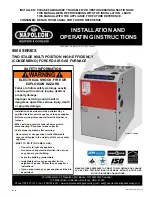
20
WARNINGS:
• Never over fire your furnace. If any part of the furnace starts to glow red, over firing is happening. Readjust
the air intake control at a lower setting.
• The installation of a log cradle or grates is not recommended in your wood furnace. Build fire directly on
firebrick.
• Never put wood above the firebrick lining of the firebox.
OPERATION
Controlled combustion is the most efficient technique for wood heating because it enables you to select the
type of combustion you want for each given situation. The wood will burn slowly if the wood furnace air intake
control’s are adjusted to reduce the oxygen supply in the combustion chamber to a minimum. On the other hand,
wood will burn quickly if the air control’s are adjusted to admit a larger quantity of oxygen in the combustion
chamber. Real operating conditions may give very different results than those obtained during testing according
to the species of wood used, its moisture content, the size and density of the pieces, the length of the chimney,
altitude and outside temperature.
RELOADING
Once you have obtained a good bed of embers, you should reload the unit. In order to do so, open the air
controls to maximum a few seconds prior to opening the furnace’s door. Then proceed by opening the door
very slowly. Then bring the red embers to the front of the furnace and reload the unit.
For optimal operation of your wood furnace, we recommend you to operate it with a wood load approximately
equivalent to the 3/4 of the height of fire bricks.
It is important to note that wood combustion consumes ambient oxygen in the room. In the case of negative
pressure, it is a good idea to allow fresh air in the room, either by opening a window slightly or by installing a fresh
air intake system on an outside wall.
Creosote - Formation and Need for Removal - When wood is burned slowly, it produces tar and other organic
vapors, which combine with expelled moisture to form creosote. The creosote vapors condense in the relatively
cool chimney flue of a slow-burning fire. As a result, creosote residue accumulates on the flue lining. When
ignited, this creosote makes an extremely hot fire. The chimney connector and chimney should be inspected at
least twice monthly during the heating season to determine if a creosote build-up has occurred. If creosote has
accumulated (3mm or more), it should be removed to reduce the risk of a chimney fire.
We strongly recommend that you install a magnetic thermometer on your smoke exhaust pipe, approximately
18” above the furnace. This thermometer will indicate the temperature of your gas exhaust fumes within the
smoke exhaust system. The ideal temperature for these gases is somewhere between 275°F and 500°F. Below
these temperatures, the build-up of creosote is promoted. Above 500 degrees, heat is wasted since a too large
quantity is lost into the atmosphere.
TO PREVENT CREOSOTE BUILD UP
OPERATION AFTER LOSS OF ELECRICAL POWER - This unit is not intended to be operated during power outage
situations. If there is a power outage while the unit is being fired, do not add more wood, close all air controls to
there minimum setting, and remove the air filter. Do not fire the unit again until power has been restored.
Always burn dry wood. This allows clean burns and higher chimney temperatures, therefore less creosote deposit.
Leave the air control full open for about 5 min. every time you reload the furnace to bring it back to proper
operating temperatures. The secondary combustion can only take place if the firebox is hot enough.
Always check for creosote deposit once every two months and have your chimney cleaned at least once a
year. If a chimney or creosote fire occurs, close all dampers immediately. Wait for the fire to go out and the
heater to cool, then inspect the chimney for damage. If no damage results, perform a chimney cleaning to
ensure there is no more creosote deposits remaining in the chimney.
ASH DISPOSAL
Whenever ashes get 3 to 4 inches deep in your firebox or ash pan, and when the fire has burned down and
cooled, remove excess ashes. Leave an ash bed approximately 1 inch deep on the firebox bottom to help
maintain a hot charcoal bed.
Ashes should be placed in a metal container with a tight-fitting lid. The closed container of ashes should be
placed on a noncombustible floor or on the ground, away from all combustible materials, pending final disposal.
The ashes should be retained in the closed container until all cinders have thoroughly cooled.
If there is a soot or creosote fire:
• Establish a routine for the storage of fuel, care for the appliance and firing techniques.
• Check daily for creosote buildup until experience shows how often cleaning is necessary.
Summary of Contents for Clayton CL1660E
Page 9: ...9 INSTALLATION ADD ON INSTALLATION...
Page 27: ...27...









































